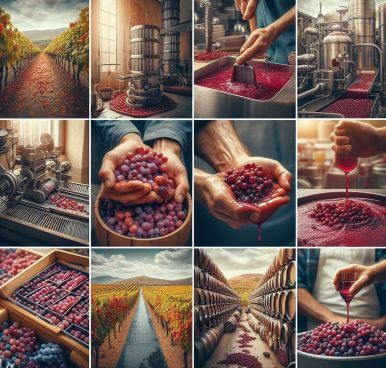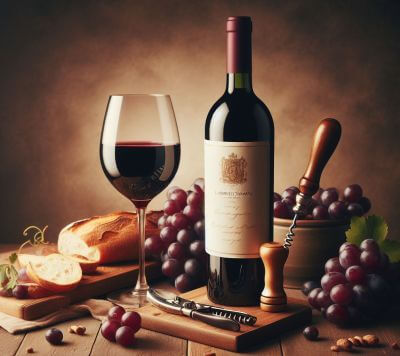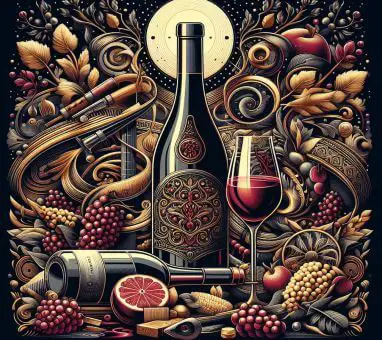Discover the characteristics of red wine, its history, rich flavours, and why it has been a popular beverage for centuries and the gentleman’s favourite.
Made from dark-colored grapes, this type of wine is known for its deep red hue, robust taste, and potential health benefits.
From the velvety smoothness of Merlot to the boldness of Cabernet Sauvignon, the red offers a wide range of flavours to suit every palate.
In this article, we will explore the various characteristics and subtypes of red wine, giving you a deeper, gentlemanly understanding of this beloved drink.
We will also hint at the history, cultural significance, and some misconceptions surrounding the red beverage.
Recommended: The Fizzy, Sparkling Wine
Recommended: The Importance of Wine Appreciation
Table of Contents
- Brief History of Red Wine
- The Red Wine Making Process
- Characteristics of Red Wine
- Subtypes of Red Wine
- Other Red Wine Varietals Worth Exploring
- Red Wine and the Gentleman
- Is Red Wine Good for You?
- Cultural Significance of Red Wine
- Red Wine Misconceptions
- Responsible Drinking and Personal Tolerance
- Selecting and Storing Red Wine
- Frequently Asked Questions
- Final Word
Recommended: The Rose Wine – Characteristics and Types
Brief History of Red Wine

Ancient Origins
The production dates back thousands of years to ancient times.
The earliest evidence of red wine production comes from the areas of Iran and Georgia, dating back to around 6000 BC.
These ancient civilizations discovered that fermenting the juice from red grapes produced a beverage with a longer shelf life compared to fresh grape juice.
Significance of Red Wine in Cultures
The red has played a significant role in various cultures throughout history.
In ancient civilizations such as Egypt, Greece, and Rome, the red held cultural and religious significance.
It was often used in religious ceremonies and was believed to have therapeutic qualities.
In Greek and Roman societies, the cultivation and consumption of the red were closely tied to social status and were enjoyed during feasts, celebrations, and gatherings.
During the Middle Ages, its production expanded throughout Europe, particularly in regions such as France, Italy, and Spain.
Monastic orders played a crucial role in wine production during this period, with monks cultivating vineyards and perfecting winemaking techniques.
In the 17th and 18th centuries, the red gained popularity among European aristocracy.
The production of wines such as Bordeaux in France and Rioja in Spain flourished during this time.
Suggested: Different Types of Wine
Red Wine Today

Today, the red beverage continues to be highly valued and celebrated in many cultures around the world.
It is enjoyed for its rich flavours and aromas, as well as its potential health benefits.
From the traditional wine regions of Europe to emerging wine-producing countries in the New World, the red remains an integral part of both cultural and gastronomic heritage.
Related: The Gentleman’s Wine Etiquette
The Red Wine Making Process

Basic Steps
The basic steps in red wine making are as follows:
1. Harvesting: Grapes are harvested from the vineyard. The timing of the harvest is crucial as it determines the sugar, acid, and tannin levels in the grapes.
2. Crushing and Pressing: The harvested grapes are crushed to release the juice. In red wine making, the grape skins, seeds, and stems are typically included in the fermentation process to extract colour and tannins.
3. Fermentation: The grape juice, now called “must,” is fermented with the skins, seeds, and stems. Yeast is added to the must to convert the sugars into alcohol. This process can take several days to a few weeks, depending on the desired style of wine.
4. Pressing: After fermentation, the solid parts of the grape (skins, seeds, and stems) are pressed to extract the remaining liquid. This liquid is then combined with the free-run juice from the initial crushing.
5. Aging: The wine is transferred to barrels or tanks for aging. This process allows the wine to develop its flavours, aromas, and complexity. The length of aging can vary depending on the type of wine being produced.
6. Bottling: Once the wine has aged to the winemaker’s satisfaction, it is bottled. Some wines may continue to age in the bottle before they are released for sale.
Related: Everything about White Wine
Different Types of Grapes in Red Wine Production

The red can be made from different types of grapes, but some of the most commonly used varieties include Cabernet Sauvignon, Pinot Noir, Merlot, Syrah, and Zinfandel.
These grapes have distinct characteristics that contribute to the flavour profile of the resulting wine.
Related: The Sparkling Red Wines
Fermentation and Aging Process
Fermentation is a crucial step in red wine making, where the grape juice, along with the skins, undergoes fermentation to convert sugar into alcohol.
This process can take anywhere from a few days to a few weeks, depending on the desired style of wine.
After fermentation, the wine is typically transferred to barrels for aging.
This aging process can range from a few months to several years, allowing the wine to develop complexity and depth of flavour.
The wine may also undergo further clarification and stabilization processes before it is bottled for consumption.
Related: Regions of Wine Production Around the Globe
Characteristics of Red Wine

One of the most distinguishing features of the red beverage is its colour, which can range from a light ruby shade to a deep purple or even brick red.
This color comes from the skins of the grapes, as they are left in contact with the juice during fermentation.
The longer the contact, the deeper the color becomes. The shades of the red beverage not only add to its aesthetic appeal but also provide a clue about the wine’s body and intensity.
Let’s take a closer look at the characteristics:
1. Color
Red wine gets its name from its distinct red hue, which can vary from light ruby to deep purple.
The color comes from the skin of the grapes used in the winemaking process.
2. Tannins
The red is known for its tannin content, which comes from the grape skins, stems, and seeds.
Tannins give the red its characteristic dry, puckering sensation in the mouth.
They also contribute to the wine’s structure and aging potential.
3. Body
It can be classified as light-bodied, medium-bodied, or full-bodied, depending on the weight and viscosity.
Light-bodied wines are often fruitier and have a thinner texture, while full-bodied wines are richer and more robust.
4. Alcohol Content
The red typically have a higher alcohol content than white wines.
The alcohol percentage can vary, but it generally falls within the range of 12-15%.
5. Aromas
The red often exhibits a wide range of aromas that can vary depending on the grape variety, winemaking techniques, and aging process.
Common aromas include red fruits (such as cherries, raspberries, and strawberries), black fruits (such as blackberries, plums, and black currants), spices, herbs, and floral notes.
6. Aging Potential
Many reds are known for their ability to age and develop complex flavors and aromas over time.
Wines made from high-quality grape varieties and aged in oak barrels can benefit from aging and can improve for several years or even decades.
7. Food Pairing
The red pairs well with a variety of foods, especially those with rich, hearty flavours.
The tannins and acidity in the wine complement dishes like red meat, game, stews, roasted vegetables, and strong cheeses.
8. Varietal Diversity
The red can be made from various grape varieties, each contributing unique characteristics.
Some popular red grape varieties include Cabernet Sauvignon, Merlot, Pinot Noir, Syrah (Shiraz), Zinfandel, Malbec, and Sangiovese.
9. Regional Influences
Different wine regions around the world produce distinct styles of red beverages due to variations in climate, soil, and winemaking traditions.
Each region contributes its unique characteristics to the final product.
10. Health Benefits: Red wine is often associated with health benefits, primarily due to the presence of antioxidants like resveratrol.
Moderate consumption has been linked to a reduced risk of heart disease, certain cancers, and age-related cognitive decline.
However, it’s essential to consume in moderation to reap these benefits.
Related: Wine Pairing with Salmon Fish
Subtypes of Red Wine
Let’s now examine the subtypes of red including:
- Cabernet Sauvignon
- Merlot
- Pinot Noir
- Syrah/Shiraz
- Zinfandel
The red can be categorized into multiple subtypes, each distinguished by its unique flavour profile and production techniques.
Some of the most popular varietals include Cabernet Sauvignon, Merlot, Pinot Noir, Syrah (or Shiraz), and Zinfandel.
Let’s examine them individually:
Cabernet Sauvignon

If you’re a fan of the red, chances are you’ve heard of Cabernet Sauvignon.
With its bold and elegant character, this esteemed variety has secured its place as one of the most popular choices worldwide.
Cabernet Sauvignon is known for its full-bodied, bold flavour with robust tannins.
It typically offers flavours of blackcurrant, blackberry, cedar, and sometimes even hints of vanilla.
It pairs well with red meats and aged cheeses, making it a favorite choice among wine enthusiasts.
Related: How to Pair Lamb and Wines
Merlot

Merlot, on the other hand, is generally smoother and less tannic compared to Cabernet Sauvignon.
It features flavours of plums, black cherries, and chocolate. Merlot is often seen as an approachable and versatile red, making it a popular choice for casual occasions or for pairing with a variety of dishes.
Pinot Noir

Pinot Noir, often described as “the heartbreak grape,” is known for its delicate and complex flavours.
It can show notes of red fruits like cherries and raspberries, along with earthy undertones.
Pinot Noir tends to be lighter in body and pairs harmoniously with dishes like roast chicken, salmon, or mushrooms.
Related: Sparkling Red Wine vs Lambrusco
Syrah or Shiraz

Syrah, also known as Shiraz in some regions, produces full-bodied red wines with intense flavours of blackberry, black pepper, and smoke.
This varietal is known for its boldness and pairs well with grilled meats and spicy dishes.
Zinfandel

Zinfandel is a varietal often associated with California.
It can range from lighter-bodied styles with flavours of raspberry and blackberry to more robust expressions with notes of black pepper and dark chocolate.
Zinfandel is particularly well-suited for barbecue or hearty stews.
Other Red Wine Varietals Worth Exploring
Apart from these varietals, the red can also be categorized by region or winemaking techniques.
For example, Bordeaux red wines come from the famous wine-growing region in France and are often blends of Cabernet Sauvignon, Merlot, and other grape varieties.
Burgundy, also in France, is renowned for its Pinot Noir wines, known for their elegance and finesse.
Rioja from Spain, Chianti from Italy, and Malbec from Argentina are just a few examples of how regional differences affect the taste and character of the red beverage.
Red Wine and the Gentleman

Red wine and the gentleman share a timeless bond, symbolizing sophistication, refinement, and indulgence.
The ruby-red hue of the wine mirrors the rich aura of the gentleman, capturing his charm and elegance.
It embodies his discerning taste and willingness to appreciate life’s pleasures.
The wine’s complex flavours and aromas evoke a sense of mystery, matching the gentleman’s enigmatic nature.
The perfect pairing of the red with food enhances not only the flavours but also the gentleman’s sense of enjoyment.
Just like a gentleman, the red beverage exudes confidence and grace, captivating all who encounter it.
Together, they reflect the art of savouring life’s simplest pleasures with poise, grace, and a touch of elegance.
Is Red Wine Good for You?
In addition to the diverse flavours and aromas, the red also offers potential health benefits when consumed in moderation as gentlemen.
Resveratrol, a compound found in grape skins, has been linked to cardiovascular health and may provide antioxidant properties.
Many studies have suggested that gentlemanly consumption of the red can reduce the risk of heart disease, certain types of cancers, and diabetes.
Whether you consider yourself a wine connoisseur or simply enjoy a glass of red occasionally, exploring the various subtypes of this beloved beverage can enhance your wine appreciation.
From the rich, full-bodied Cabernet Sauvignons to the delicate and complex Pinot Noirs, each varietal of the red brings its unique charm to the glass.
So next time you pour yourself a glass, take a moment to savour the flavours, appreciate the artistry, and toast to the centuries-old tradition of red wine.
Cultural Significance of Red Wine
Cultural and Religious Contexts
The red holds great cultural significance in many societies around the world.
It has been enjoyed for centuries and is often associated with various rituals, ceremonies, and social occasions.
In religious contexts, the red beverage holds particular importance.
For example, in Christianity, it symbolizes the blood of Christ during the Eucharist or Communion.
The act of drinking the wine serves as a reminder of Jesus’ sacrifice and communion with God.
Similarly, in Judaism, it plays a crucial role in the Passover Seder, symbolizing redemption and freedom.
Social and Romantic Occasions
The red has a significant role in social gatherings and cultural traditions.
In many countries, it is a staple at dinner parties, weddings, family gatherings, and festivals.
Wine-tasting events and vineyard visits have become popular ways to experience and appreciate different varieties of the red.
Sharing a bottle of the red has also become a way to sustain relationships, engage in conversations, and connect with others.
Its rich color and complex flavours make it a favorite choice for toasting and enjoying with loved ones.
It is also commonly associated with romantic occasions and is often paired with candlelit dinners or intimate gatherings.
It is seen as a symbol of sophistication and an enhancer of the overall experience.
Red Wine Misconceptions
Sulfite Content
Many individuals believe that red wine is high in sulfites, which can cause allergies or headaches.
However, the truth is that the sulfite levels the wine are typically lower compared to dried fruits or some processed foods.
Only a small percentage of people are sensitive to sulfites, and it’s rare for the red to cause headaches solely due to sulfite content.
2. Health Benefits
While red contains antioxidants and some health benefits when consumed in moderation, it is not a cure-all or a replacement for a healthy lifestyle.
The idea that it is the key to good health is a misconception that should not overshadow a balanced diet and regular exercise.
Responsible Drinking and Personal Tolerance
1. Moderation
It’s crucial to understand the concept of moderation when it comes to drinking the red.
A responsible approach is to adhere to recommended guidelines, which suggest no more than one glass per day for women and two glasses for men.
2. Personal Tolerance
Everyone’s body reacts differently to alcohol. Understanding your tolerance is essential to ensure you do not exceed your limits.
It’s important to know when to stop and avoid excessive consumption that could lead to negative health effects.
Selecting and Storing Red Wine
1. Check the Vintage
When selecting any of the red subtype, pay attention to the vintage year on the bottle.
Some years may have produced better-quality wines than others.
2. Consider Food Pairing
Different subtypes of red complement different types of food.
Consider the flavours and characteristics of both the wine and the dish to enhance the overall dining experience.
3. Storage Conditions
Proper storage is crucial to maintaining the quality and taste of red wine.
Keep it stored in a cool, dark place with a consistent temperature, preferably between 50-59°F (10-15°C). Avoid exposure to light and temperature fluctuations.
4. Aging Potential
Not all reds are suitable for aging. Research the particular bottle’s aging potential to determine whether it should be consumed promptly or if it will develop more complexity and depth over time.
By understanding and dispelling misconceptions, promoting responsible drinking, and following tips for selection and storage, you as a gentleman can enhance their enjoyment and appreciation of the wine while maintaining a healthy approach.
Frequently Asked Questions
What are the five characteristics of red wine?
Five characteristics of the red include body, tannin, acidity, flavor profile, and aroma, which contribute to its overall taste and experience.
What are the different types of red wines?
Different types of the red include Cabernet Sauvignon, Merlot, Pinot Noir, Syrah, and Zinfandel, each with unique flavours and characteristics.
What are the characteristics of red wine?
The characteristics of the red covers aspects such as body, acidity, tannin, sweetness, and aroma, which define its taste and quality.
How do you classify red wine?
It is classified based on the grape variety, region, aging process, and flavour profile, leading to categories such as Cabernet Sauvignon, Merlot, and Pinot Noir.
Final Word
Red wine covers rich flavours and styles, including Cabernet Sauvignon, Merlot, Pinot Noir, Syrah, and Zinfandel, each offering distinct characteristics and twists.
As we conclude, I encourage you to explore and appreciate the vast world of wine.
Expand your knowledge through vineyard tours, wine tastings, and food pairings, and continue to savour the diverse expressions of this timeless beverage.
Cheers to further learning and unforgettable tasting experiences!
References:
- https://www.thespruceeats.com/types-of-red-wine-3511068
- https://www.wineenthusiast.com/basics/red-wine-basics/
- https://www.thrillist.com/drink/nation/red-wine-types-explained
- https://medium.com/@chaddsford/what-are-the-characteristic-of-red-wine-59923570b5a4
Pyo Merez is a men’s lifestyle enthusiast and writer about the gentleman’s place and impact on society. Raised by a distinguished gentleman dad, he offers unique insights into how the mind of a gentleman works and how societal norms shape gentlemen’s identity and vice versa.
Through his insightful articles, Pyo taps into the depths of gentleman culture to provide perspectives on etiquette and manners in modern society.

